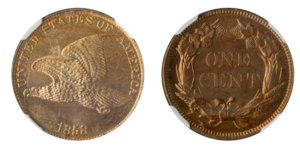The 1857 Flying Eagle Cent: Beloved by Collectors for Many Reasons
Posted on — Leave a commentThe year 1857 in American history included many significant events. These included the tragic sinking of the S.S. Central America off the coast of North Carolina, the Panic of 1857 (exacerbated, in part, by the financial loss from the S.S. Central America) which saw New York banks close in October, not to reopen until mid-December of that year, and Congress banned the use of foreign coins as legal tender.

In the numismatic world the Flying Eagle cent was released for circulation in May of that year—and collectors today still eagerly search out this popular series.
The 1857 Flying Eagle Cent marked a major shift in copper cents from large cents to small cents. There were a few reasons why this change was made. First, the price of copper was rising, increasing the costs to produce large cents. The second reason was more pragmatic. Americans simply didn’t like them. They were ugly, heavy and cumbersome.
In 1856, as Congress deliberated on legislation that would allow the production of new coinage, Mint officials created the 1856 Flying Eagle cent pattern coin present. It was well received and Congress passed the Coinage Act of 1857, authorizing a new small cent made from a mixture of copper and nickel.
This Act also outlined a process for Americans to turn in their large cents in exchange for the new small cent. The public loved it and when the Mint began official distribution of the Flying Eagle Cent in May 1857, long lines formed as people waited to trade in their old coins for the shiny new smaller cent.
Dramatic Coin Design
Mint Chief Engraver James Barton Longacre designed this dramatic coin. The obverse features a left-facing eagle with its wings outstretched in flight. Around the top, UNITED STATES OF AMERICA encircles the top two-thirds of the coin, with the date at bottom. The image of the eagle was influenced by work from Longacre’s predecessor, Christian Gobrecht.
On the reverse, a detailed wreath comprised of leaves, corn seed heads, wheat, cotton and tobacco is wrapped in a ribbon. Centered on the reverse are the words ONE CENT. All coins were minted at Philadelphia and so there are no mint marks on the coins.
In High Demand
The Flying Eagle was only minted until 1858. Striking problems occurred with the high-relief design, which triggered a design shift. The Indian Head cent replaced the Flying Eagle in 1859, making the Flying Eagle a short-lived but beloved coin series. The exciting history, show stopping design and its place in numismatic history as the first small cent make Flying Eagle Cents a highly collected series. Collectors typically want to acquire the 1856 pattern and the 1857 and 1858 coins. When they emerge for sale, they typically don’t last long. We have just one of these beautiful coins. See the 1857 Flying Eagle Cent here.
Related Reading:








